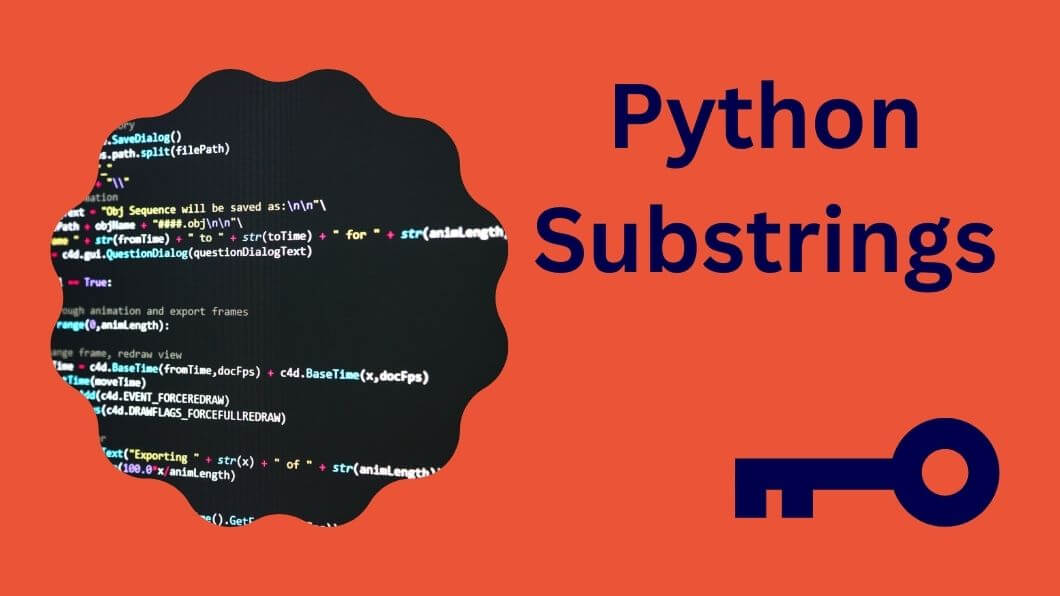Introduction
In Python programming, understanding how to manipulate and extract substrings is a fundamental skill.
Python substrings operations allow you to efficiently work with portions of strings extract, modify, or analyze specific text segments.
In this comprehensive directory, we will thoroughly explore all aspects of the Python substrings operations, equipping you with the knowledge and skills required to use this powerful tool effectively.

What is a Python Substring?
Before diving in deeper, let’s define what a Python substring means. A substring in Python refers to any contiguous sequence of characters within a string – similar to extracting characters from its starting point until its ending point (or until its entirety is reached if no such endpoint has been specified).
Basics of Python Substrings
Extracting a Substring
To extract a substring in Python, you can use slicing. The basic syntax for slicing a string is as follows:
The code
substring = original_string[start:stop]
Where:
- original_string is the string from which you want to extract the substring.
- start is the index at which the substring begins (inclusive).
- stop is the index at which the substring ends (exclusive).
Let’s look at an example:
The code
original_string = “PythonSubstring”
substring = original_string[6:12]
print(substring) # Output: “Substr”
In this example, we extracted the substring “Substr” from the original_string by specifying the starting index as 6 and the stopping index as 12.
Omitting Start and Stop Indices
If you omit the start and stop indices, Python assumes default values. The default start index is 0, and the default stop index is the length of the string. This means that original_string[:] would return the entire string.
The code
original_string = “PythonSubstring”
substring = original_string[:]
print(substring) # Output: “PythonSubstring”
Negative Indices
Python also supports negative indices for slicing. A negative index counts from the end of the string, with -1 representing the last character. For example:
The code
original_string = “PythonSubstring”
substring = original_string[-6:-1]
print(substring) # Output: “Strin”
We extracted the substring “Strin” using negative indices in this case.
Practical Applications

Understanding how to extract substrings is invaluable in various programming scenarios. Here are some practical applications:
Data Cleaning
When working with messy data, you should clean up strings by removing unwanted characters or extracting specific information. Python substrings make this task manageable.
Text Parsing
In natural language processing and text analysis, you often need to isolate parts of text for analysis. Substrings help you segment text into meaningful units for further processing.
Password Validation
In user authentication systems, you should check if a password fulfills certain criteria, such as minimum length or containing specific characters. Substring operations can assist in implementing these checks.
Advanced Substring Techniques
Now that we’ve covered the basics let’s explore some advanced techniques for working with Python substrings.
Searching for Substrings

You can check if a substring exists within a string using the in keyword or the find() method. The find() method also allows you to specify a starting index for the search.
The code
text = “Python is a versatile language”
substring = “versatile”
if substring in text:
print(“Substring found!”)
# Using find() with a starting index
index = text.find(“a”, 10) # Search for “a” starting from index 10
print(index) # Output: 13
Replacing Substrings
To replace occurrences of a substring within a string, you can use the replace() method.
pythonCopy code
text = “Python is a versatile language”
new_text = text.replace(“versatile”, “powerful”)
print(new_text) # Output: “Python is a powerful language”
Splitting Strings
The split() method allows you to split a string into a list of substrings based on a delimiter.
The code
text = “apple,banana,cherry”
fruits = text.split(“,”)
print(fruits) # Output: [‘apple’, ‘banana’, ‘cherry’]
Joining Strings
Conversely, you can join a list of strings into a single string using the join() method.
The code
fruits = [‘apple’, ‘banana’, ‘cherry’]
text = “,”.join(fruits)
print(text) # Output: “apple,banana,cherry”
Checking for Prefix and Suffix
You can determine if a string starts or ends with a particular substring using the startswith() and endswith() methods, respectively.
The code
text = “Python is great”
print(text.startswith(“Python”)) # Output: True
print(text.endswith(“awesome”)) # Output: False
Conclusion
In this extensive guide, we’ve delved deep into the world of Python substrings. From the basics of slicing to advanced techniques like searching, replacing, splitting, and joining strings, you now possess a comprehensive understanding of how to work with substrings effectively in Python.
Mastering substring manipulation unlocks an incredible wealth of opportunities in Python programming, enabling you to handle text data with finesse and precision.
From cleaning data, parsing text documents or developing complex algorithms – mastery of substring manipulation will become an indispensable tools on your Python journey!
So, harness the power of Python substrings to elevate your coding prowess to new heights. Happy coding!
Remember, practice makes perfect, so experiment with Python substrings in your own projects to reinforce your understanding and creativity. Python substring manipulation is a skill that will undoubtedly prove its worth time and time again in your coding endeavors.
Frequently Asked Questions
What is a Python substring, and why is it essential in programming?
A Python substring refers to any contiguous sequence of characters within a string, allowing you to extract, modify, or analyze specific text segments.
It’s crucial in programming as it enables efficient text manipulation, making tasks like data cleaning, text parsing, and password validation manageable.
How do I extract a substring in Python?
To extract a substring in Python, you can use slicing. The syntax is as follows:
The code
substring = original_string[start:stop]
Where original_string is the source string, start is the inclusive starting index, and stop is the exclusive ending index. Omitting start and stop defaults to extracting the entire string.
What are some practical applications of Python substrings?
Python substrings find utility in various programming scenarios, including:
- Data Cleaning: Removing unwanted characters or extracting specific information from messy data.
- Text Parsing: Isolating text parts for analysis in natural language processing and text analysis.
- Password Validation: Checking if passwords meet criteria such as length or character inclusion.
Are there advanced techniques for working with Python substrings?
Certainly! Some advanced techniques for Python substrings include:
- Searching for Substrings: Using the in keyword or the find() method to check if a substring exists within a string.
- Replacing Substrings: Employing the replace() method to replace occurrences of a substring within a string.
- Splitting Strings: Using the split() method to split a string into a list of substrings based on a delimiter.
- Joining Strings: The join() method combines a list of strings into a single string.
- Checking for Prefix and Suffix: Determining if a string starts or ends with a particular substring using the startswith() and endswith() methods.
These advanced techniques expand your capabilities in text manipulation and data processing.
